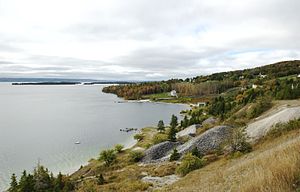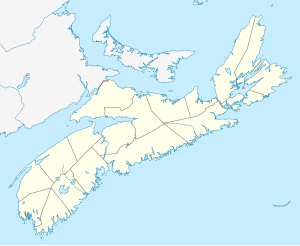Bras d'Or Lake
| Bras d'Or Lake | ||
|---|---|---|

|
||
| Shore view at Marble Mountain | ||
| Geographical location | Nova Scotia | |
| Data | ||
| Coordinates | 45 ° 51 ′ N , 60 ° 49 ′ W | |
|
|
||
| surface | 1 100 km² | |
| length | 80 km | |
| width | 30 km | |
| volume | 32,000,000,000 m³ | |
| Maximum depth | 287 m | |

|
||
The Bras d'Or Lake (sometimes also referred to as the Bras d'Or Lakes or Bras d'Or lake system) is an approximately 1,100 km² Canadian lake that defines the center of Cape Breton Island . The lake is often referred to as the estuary or bay of the Atlantic, as it is connected to the open sea by two natural channels and thus has a fjord-like character with light tides and brackish water .
The name of the lake goes back to the first French settlers and means "golden arm". The local Mi'kmaq gave the lake the name Pitu'pok (approximate translation "salt water").
Part of the lake and its surroundings form a Biosphere Reserve of UNESCO , which was set 2011th
geography
The Bras d'Or is almost 80 km long, 30 km wide, almost completely surrounded by hills and low mountains and strongly subdivided. The southern part of the lake is connected to the northern part by Barra Street, which is only about 1 km wide. A road and a railway bridge span this part of the lake.
The southern part of the Bras d'Or consists of a larger water surface of over 30 km in diameter and some bays. The narrow isthmus of St. Peter separated this part of the lake from the open sea until the St. Peter Channel was built. The northern part, on the other hand, is composed of three narrow arms and connected to the open ocean by two natural channels that surround the Bouladerie Island. Numerous small rivers and streams flow into the Bras d'Or Lake.
Due to the limited access to the sea, the tides and salinity of the lake are low. The salinity of the surface water decreases to 20 ppm towards the east and is even lower near larger tributaries and in protected bays. The Bras d'Or has typical estuary currents. Salty sea water flows deep into the lake, while low-salt surface water flows into the sea.
In winter the lake is almost completely covered with ice. In summer it warms up to a little over 22 ° C.
geology
The present lake was formed after the glaciers retreated at the end of the last ice age around 10,000 years ago. Due to various uplifts and subsidence of the country, the Bras d'Or Lake was temporarily a freshwater lake closed off from the sea. However, it has been connected to the sea again for around 4,500 years.
Since the lake bed has not yet been explored, the assessment of the subsurface is based on studies of the surrounding land. Presumably the lake bed consists of sedimentary rocks , especially slate and sandstone . A gravity anomaly in the western bay indicates salt deposits underground.
Most of the lake occupies a regional lowland, but some deep cuts (up to 280 m) may have been formed by glaciers during the Ice Age. Some of the cliffs that border the lake are unusual as they contain organic sediments from the last Ice Age. These can provide research with information about previous climatic conditions .
Flora and fauna
The vegetation is similar to that in the neighboring Gulf of Saint Lawrence . Because of the winter glaciation, plants in the intertidal zone only occur at greater depths. In sheltered bays with lower salinity there is limited freshwater swamp vegetation.
The fauna of Bras d'Or Lake is made up of species from both southern and northern areas. The multi- bristle fauna, for example, is typical of temperate North American waters, but arctic species are also present. Other representatives for warmer waters are the American oyster and the sand shrimp . The fish fauna includes sticklebacks , herrings , Greenland halibut and rainbow trout . These are the basis for a large population of waterfowl ( e.g. great blue herons , cormorants and bald eagles ).
Culture
The Bras d'Or Lake is of great cultural importance for the Mi'kmaq people . On Chapel Island (Mniku) is the Mi'kmaq Grand Council (Great Council of the Mi'kmaq). The island has been declared a Historic Site in Canada. An Indian cultural center has also been established just north of Port Hawkesbury. Here the First Nations can preserve their art and culture and the leading chiefs meet there to discuss important issues of their tribes.
Furthermore, the area around the Bras d'Or is a center of the Scottish population of Nova Scotia .
Economy and Shipping
There is still fishing and lobster fishing on the lake ; However, aquacultures (especially oysters and salmon) are of far greater economic importance .
In the 19th and first half of the 20th century, commercial shipping was of great importance. Various industrial products from Cape Breton Island were transported south to mainland Nova Scotia via Bras d'Or Lake and the St. Peters Canal. Until the construction of modern roads, the places on the lake were also supplied by coastal freighters. Shipping is currently limited to the transport of plaster of paris and wood.
tourism
Today the Bras d'Or Lake is a preferred vacation area. The varied coastline with numerous bays, islands and harbors makes the lake a popular area for sailors . The communities around the lake offer numerous marinas , golf clubs and other facilities.
environment
The lake has two entrances to the Atlantic. One of them is the canal at St. Peters, in the southeast of Cape Breton. The increasing use of the lake for tourism and other purposes makes the region increasingly attractive. The local wildlife has bald eagles, elk, deer and beavers.
Others
The famous inventor Alexander Graham Bell had his summer residence in Beinn Bhreagh on Bras d'Or Lake. During this time he experimented with various unmanned aerial vehicles. These attempts ultimately led to the AEA Silver Dart , which took off from the frozen Bras d'Or Lake on February 23, 1909 and carried out the first controlled powered flight in Canada and the British Empire .
Bell also worked on the development of hydrofoils . In 1919, the first official world speed record for watercraft was set on the Bras d'Or . In recognition of AG Bell's accomplishments, the Canadian Navy named its experimental wing ASW HMCS Bras d'Or in the 1960s . The Alexander Graham Bell Museum in Baddeck was dedicated to him in his honor.
Web links
- Tourist Office, Nova Scotia English
- greatcanadianlakes.com English
Individual evidence
- ↑ UNESCO Biosphere Reserves. Bras d'Or Lake. In: Ecological Sciences for Sustainable Development. UNESCO , accessed April 11, 2013 .
